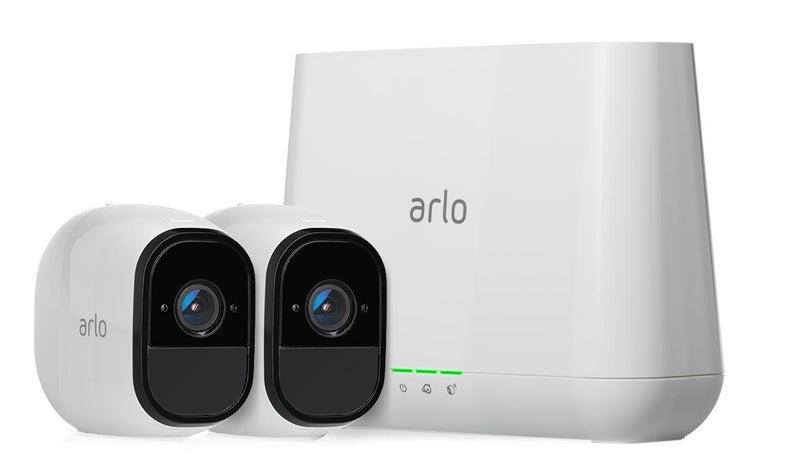Netgear Arlo Pro Review: A connected security camera with connectivity issues
This smart security imaging system works well...when it works.

We may earn revenue from the products available on this page and participate in affiliate programs. Learn more ›

In an increasingly crowded field of smart home security cameras, the Arlo Pro sets itself apart from the competition with a long-lasting rechargeable battery, plenty of wireless mounting options, and a week’s worth of cloud video storage for free.
Testing
We tested the two-camera kit, which also comes with a Netgear base station. This hub connects directly to your router via ethernet cable and serves as both a dedicated Wi-Fi extender and a private camera network. According to Netgear, the cameras “talk” to the station via a secure wireless connection that only they can use, and can maintain a connection within 300 feet—an accurate assessment based on our test.
Setting things up is as simple as loading the rechargeable batteries (mercifully, they come pre-charged) into each camera, connecting the base station, and syncing the cameras to the base with the Arlo app.
While you can use the Arlo Pros indoors or out, robust waterproofing and wireless mounting make them particularly well suited for outdoor use. We installed one above our front door and mounted the other in the corner above the backyard porch. The kit comes with two rounded (and magnetized) mounting plates. Once you’ve secured one to the wall, you just stick the concave butt of the camera on it and adjust its position as needed. Yes, this means that anyone can walk off with your security camera (we see the irony), so it’s a good idea to mount them high and out-of-sight.

Observations
The problems for us revolve around reliability. For the month we spent testing the cameras, we noticed that many of the triggered video events were severely glitchy, often with a couple 1-2 second chunks completely indecipherable thanks to weird flashing green blobs of distortion. That’s pretty big problem if, say, the video you’re trying to watch is of someone breaking into your house.
Because all the communication between the cameras goes through the base station, you have to connect to that first before making any changes to your camera modes. This was frequently hit-or-miss when we were outside the house. Sometimes we would connect with no problem. Others, the Netgear app would hang, and we’d have to restart it entirely. Occasionally, we’d have to launch and restart the app multiple times before we could connect.
Even starting up the Arlo app was sometimes an iffy proposition. It frequently crashed or would report that it couldn’t find our Arlo account when we tried to sign in. Whether this was a problem with the app itself or some flaw in the hardware, it’s hard to say. To be fair, none of the security cameras we’ve tested so far are completely free of these types of issues. But we’ve gotta ask: What’s the point of owning a security camera if you can’t count on it to work the vast majority of the time?
Here’s the thing about the Arlo Pro cameras: When they work, they work marvelously. Image quality is good, features like two-way audio and night vision are great, and it’s easy to dial in the motion sensitivity on the cameras so that they capture (and alert you to) only significant events—like the movement of people and not, say, the swaying of branches. The problem is performance can often be spotty. And that’s not good for a security camera.

Most security cameras require you to buy a monthly plan in order to access previously recorded videos. Depending on how many days you want stored in the cloud, these plans can range from around $3/month all the way up to $30. With the Arlo Pro, you get seven days’ worth of free storage for up to five cameras, which should be plenty for most people, but there are upgrade options for longer storage time and more cameras for power users. For comparison, a Nest Aware 10-day subscription plan demands $10/month (or $100/year) for your first camera, and $5/month (or $50/year) for each additional camera. A subscription-less Nest only gets you snapshots of the past 3 hours of triggered events and no link to the associated video.
We also liked that the Arlo Pro base station has a built-in 100-decibel siren (that’s about as loud as a jackhammer). You can activate it directly from the Arlo app or create a custom Arlo mode that sets it off if, for instance, one of your cameras sees or hears something.
Those modes are easy to create, too. For example, you can set up a schedule-based one that turns the cameras on only during certain times of the day, or a geofencing one based on your phone’s location.
Battery life continues to be great. After about a month of regular use, both cameras are at about 85 percent. Video quality is generally good, too, but with more and more wireless security cameras now offering 1080p resolution, it’s worth noting that the Arlo Pro tops out at 720p. Practically speaking, that’s not a huge difference in the image quality, but we found that that extra resolution on a camera like the Nest Outdoor comes in handy when you’re zooming in. Under normal viewing circumstances, however, 720p is fine.
Conclusion
There’s plenty to like about the Arlo Pro on paper, but we experienced too many reliability issues for a device dedicated to security. Even the free 7-day cloud video storage, a robust array of useful accessories, and the long battery life, can’t overcome its glitches.
Details
Video resolution: Configurable up to 1280 x 720
Video format: H.264
Wireless range: 300+ feet line of sight
Wireless: 2.4GHz, 802.11n
Field of view: 130°